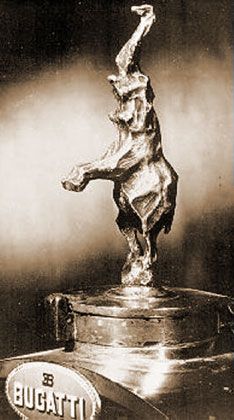LEMPICKA, BUGATTI AND A DANCING ELEPHANT
A portrait staged inside of a car? Something like that could only happen in the wild twenties. When the automotive industry was just starting out, the car was treated as a work of art, an icon of modernity, a symbol of independence and emancipation of women. In 1929 at the request of the German magazine Die Dame published Tamara Lempicka painted Self-portrait in a green Bugatti – one of the most famous and most frequently reproduced paintings in the world. On one hand so much has already been said about this piece of art but till today nobody knows which Bugatti model was presented by the artist on the painting as one can see only a small fragment of it.

foto: Bugatti & text: Marta Kropidłowska
Knowing, however, a few facts from Lempicka’s biography – her passion for luxury and the desire to make her life unique, plus the fact that Bugatti Royale was the greatest car of its time – it is quite probable to assume that it was this very model of Bugatti in which Łempicka decided to immortalize herself.
One should also add that the long-awaited premiere of this model took place in 1929, in the same year when Tamara painted Self-portrait. Moreover, it is known that one of the copies of Royale had this very unusual shade of sea green and a collapsible roof made of black canvas, which one can notice on the painting. This unique vehicle was designed by a brilliant engineer and visionary – Ettore Bugatti. For him cars were synonymous with beauty, elegance and state-of-the-art technology. In the 1920s all the great, famous and rich dreamed of driving his car from Alsatian Mulhouse. Bugatti Type 41, known as the Royale was supposed to be Ettore’s masterpiece and it indeed was. There was no car like it before. Completely hand-built, with a length of 6.5 meters and a 12.7-liter engine with 300 horsepower.
The name itself suggests who the car was intended for. In individual copies of Royale, only the chassis, engine and front shape were the identical. The cabin and interior – were made of top quality leather and wood, they were constructed according to the customer’s guidelines. And the fact that each copy of the model was unique confirms the unique and luxurious character of this car in the best manner possible. This and also the price. It was supposed to create an obstacle for most and it did. The Bugatti Royale chassis itself cost twice as much as the most expensive Rolls-Royce model.
The exterior appearance of the limousine was stunningly breath-taking. The hood covered more than half its length, huge circles with a beautiful line of fenders and four large headlights drew the attention. Body – in high gloss incorporated numerous chrome accents to underline the elegance of the vehicle. What really attracts the eyes is replica of Rembrandt’s dancing elephant on the cooler. The piece was not made by Rembrandt van Rijn, but by Ettore’s brother, Rembrandt Bugatti, who was a well-known sculptor from the early twentieth century. In the interwar period as a rule the hoods of the most luxurious cars had to be decorated with mascots and symbols of the manufacturers. Ettore Bugatti resisted this tradition for a long time. His vehicles had only a simple red logo in that spot. It was only after designing Royale, his largest, most expensive and most luxurious model when he finally gave up and the dancing elephant became one of the most recognizable brand symbols in the history.
Unfortunately, the premiere of this magnificent car which is purposed for the richest people in the world coincided with the great economic crisis which began on the 24th of October 1929 initiated by the Wall Street crash. Consequently, only six copies of Royale were made and three of them were sold.
When the mystery of the car from the painting seems clear, one question still remains:
Did Lempicka actually drive a Bugatti? She was a popular painter and loved luxury… Well, the truth was not so splendid – when Tamara was painting her Self-portrait in a green Bugatti she was actually an owner of a small yellow Renault.




